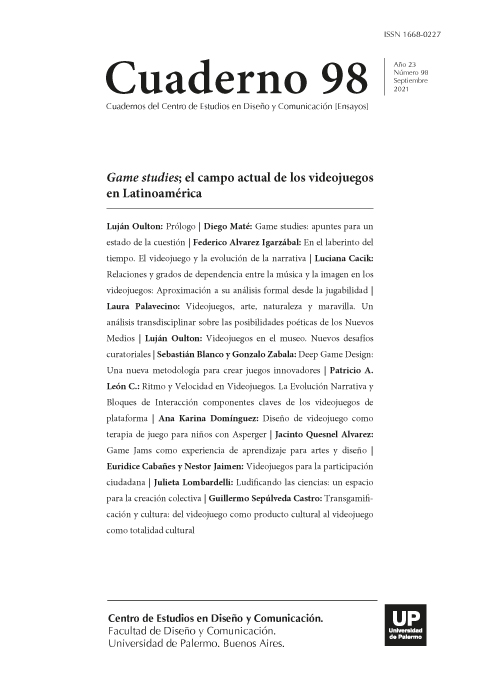Game Jams como experiencia de aprendizaje para artes y diseño
Abstract
With the digitalization and evolution of tools, processes and means of expression in the professional task of the arts and design, the need to take advantage of new competences emerges. In this document, in addition to theoretically substantiating this need, the possibilities of the Game Jams and other activities related to the creation of video games for that purpose are explored. Based on the participant observation of a case, the mentioned phenomenon, its play, its antecedents and its repercussions are studied. It builds a useful representation of the internal logic of the creation of games and their learning process, not only in terms of digital literacy aspects (when it comes to video games), but also around the symbolic representation and human link necessary to designers, artists and creatives in general.
References
Arya, A., Chastine, J., Preston, J., & Fowler, A. (2013). An International Study on Learning and Process Choices in the Global Game Jam. International Journal of Game-Based Learning. https://doi.org/10.4018/ijgbl.2013100103
Bushnell, N. (1982). Nolan Bushnell - Interview Part 1. Recuperado de https://youtu.be/h93eLDhHqY8?t=4m43s
Cabañez, E., Shaku, G., Martín, A., & Romero, L. (2013). Sinapsis. Recuperado de http://youtu.be/kND40S8LDqc
Caillois, R. (1961) Los juegos y los hombres, la máscara y el vértigo (ed. 1986). Fondo de Cultura Económica.
Deeg, C., Salvatore, M., Rackwitz, R., Quesnel, J., Neiburger, E., Guerrero Merchant, H., & Dávalos, Y. (2017). El conocimiento sale a jugar - Gaming y Gamification en bibliotecas. Recuperado de https://www.goethe.de/ins/mx/es/kul/sup/cmp/wgs/20977192.html
Dewey, J., & Ramos, S. (1949). El arte como experiencia (ed. 2008). Barcelona: Paidós. Recuperado de http://www2.eci.ufmg.br/greenstone/collect/livros/index/assoc/HASH019d.dir/doc.doc
Díaz Barriga, F. (2003). Cognición situada y estrategias para el aprendizaje significativo. Revista Electrónica de Investigación Educativa, 5(2), 1–13.
Díaz Barriga, F. (2006). Enseñanza situada: vínculo entre la escuela y la vida. Editorial McGrawHill. México. McGrawHill. Recuperado de http://orton.catie.ac.cr/cgi-bin/wxis.exe/?IsisScript=SUV.xis&method=post&formato=2&cantidad=1&expresion=m fn=005974
Fowler, A., Khosmood, F., Arya, A., & Lai, G. (2013). The Global Game Jam for Teaching and Learning. Proceedings of 4th Annual Conference of Computing and Information Technology Research and Education New Zealand.
Fowler, A., Pirker, J., Pollock, I., de Paula, B. C., Echeveste, M. E., & Gómez, M. J. (2016). Understanding the benefits of game jams: Exploring the potential for engaging young learners in STEM. In Proceedings of the 2016 ITiCSE Working Group Reports (pp. 119–135).
Freire, P. (1966). Pedagogía de la Autonomía. Educación y Territorio (11va ed.). Siglo XXI Editores.
Fullerton, T. (2008). Game design workshop: a playcentric approach to creating innovative games. Taylor & Francis US.
Garfias Frías, J. Á. D. (Ed.). (2017). Aportes a la construcción de teorías del videojuego. Universidad Nacional Autónoma de México.
Greenfield, P. M. (1994). Video games as cultural artifacts. Journal of Applied Developmental Psychology, 15(1), 3–12.
Guerrero, H., Aguilar Rodríguez, A., & Mondoza, A. (2013). Allum. Recuperado de https://youtu.be/RNg7_BVsHCU
Huizinga, J. (1954). Homo Ludens (ed. 2007). Alianza Editorial.
Levy, E. (2012). Game Design is Business Design. Game Developers Conference Online. Game Developers Conference Online. Recuperado de http://www.gdcvault.com/play/1016686/Game-Design-is-Business
Malagón Mosqueda, E. (2010). El Espejo, Fundamentos del aprendizaje humano.
Musil, J., Schweda, A., Winkler, D., & Biffl, S. (2010). Synthesized essence: what game jams teach about prototyping of new software products. 2010 ACM/IEEE 32nd International Conference on Software Engineering. https://doi.org/10.1145/1810295.1810325
Poulsen, M., & Gatzidis, C. (2010). Understanding the Game: An Examination of Ludoliteracy. Game Studies. Recuperado de http://eprints.bournemouth.ac.uk/16743/1/licence.txt
Prensky, P. M. (2010). Nativos e Inmigrantes Digitales. Cuadrenos SEK 2.O, (M-24433-2010), 21. https://doi.org/http://hdl.handle.net/10230/21226
Preston, J. A., Chastine, J., O’Donnell, C., Tseng, T., & MacIntyre, B. (2012). Game Jams: Community, Motivations, and Learning among Jammers. International Journal of GameBased Learning, 2(3), 51–70. https://doi.org/10.4018/ijgbl.2012070104
Quesnel, J., Alegría, S., & Sánchez, G. (2014). Laboratorio de experimentación en videojuegos. Recuperado de https://laboratoriodejuegos.wordpress.com/
Ruiz, C. (2013, November 6). Más videojuegos que cine y música. 24 Horas. Recuperado de http://www.24-horas.mx/mas-videojuegos-que-cine-y-musica/
Sánchez Garrido, V., Siara, N., Toxqui Cano, H., & Ciriaco Ramírez, Y. A. (2013). Eco-oo. Recuperado de https://youtu.be/ivMvTV4uGa0
Schaub, H., & Zenke, K. G. (2001). Diccionario Akal de pedagogía (Vol. 30). Ediciones AKAL.
Turner, J., Owen, C., & Thomas, L. (2013). Living the indie life: mapping creative teams in a 48 hour game jam and playing with data. IE’13 Proceedings of The 9th …. https://doi.org/10.1145/2513002.2513039
Vera, J. L. (1989). Neotenia y evolución humana. Escuela Nacional de Antropología e Historia.
Zagal, J. P. (2010). Ludoliteracy : Defining , Understanding , and Support- ing Games Education. Most, 162. Recuperado de http://www.ludoliteracy.com/
Los autores/as que publiquen en esta revista ceden los derechos de autor y de publicación a "Cuadernos del Centro de Estudios de Diseño y Comunicación", Aceptando el registro de su trabajo bajo una licencia de atribución de Creative Commons, que permite a terceros utilizar lo publicado siempre que de el crédito pertinente a los autores y a esta revista.


